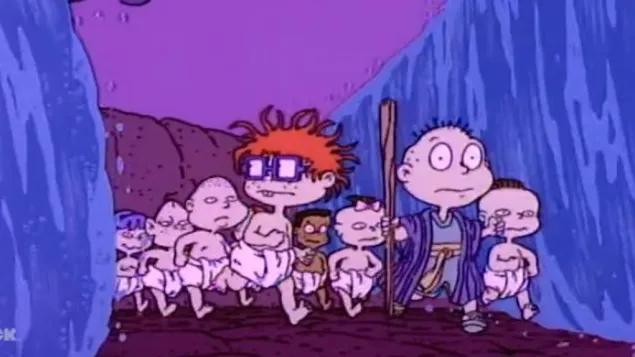
In 1992, I was a recent college graduate who had moved to Los Angeles in the hopes of making a career as a screenwriter. A few happy accidents landed me work as a writer for a new series on Nickelodeon, Rugrats. Rugrats was one of three shows launched under the banner of Nicktoons that would dramatically change the nature of animation programming. In the early ‘90s, children’s animation was dominated by “Saturday morning cartoons” that aired on the major broadcast networks; the networks favored hastily written, cheaply animated series based on popular toys, existing entertainment properties, or concepts such as Prostars, which featured sports heroes Michael Jordan, Wayne Gretzky and Bo Jackson fighting crime. Nickelodeon broke from this model in creating original content, based on nothing but the imagination of writers and artists, which emphasized well-crafted stories and distinctive visual design. While another series, Ren and Stimpy, initially looked to be Nickelodeon’s breakout hit because of its appeal to college students, Rugrats ultimately proved to be the more durable, popular, and acclaimed series.
The writing staff was small, about four or five of us at any given time. It was led by Paul Germain, executive producer, co-creator, and the primary creative force behind the series. (Internet fans will tell you that the show “jumped the shark” after Paul left the production company, Klasky-Csupo Animation, to develop original programming at Disney). Under Paul’s supervision, as well as that of the immensely talented head writer Joe Ansolabehere, the staff was directed to create playful but narratively coherent stories designed to foster emotional connections between our characters and the children who watched them. With that governing philosophy, we had written a successful Christmas special; the following year the executives at Nickelodeon asked Paul to devise a Hanukkah story.
When Paul pitched the idea to the writing staff, I was cool to it. Because of my Jewish upbringing, I pointed out that in the Jewish tradition, Hanukkah is a minor holiday, one which grew in popularity only as Jews sought to assimilate to a dominant Christian culture. The more important Jewish holiday is Passover, which celebrates the Jews’ liberation from slavery in Egypt as related in Book of Exodus.
Furthermore, Passover came with a ready-made storyline, the exodus itself, popularized for my generation through the 1956 Cecil B. DeMille epic, The Ten Commandments. Indeed, an essential part of the Passover tradition is the telling of the story, so that the value of narrative as a commemorative and educational act is essential to the holiday. Even better, we instantly recognized that there was a natural fit between the theme of the holiday—freedom—and the theme of Rugrats, which featured, in almost every episode, Tommy Pickles escaping from captivity in his playpen and exploring the wide world from which his parents attempted (not very effectively) to protect him. In other words, the desire of the Jews (and all peoples) for freedom found a deep and powerful parallel in the desire of all children to be independent—to break free of needless and oppressive adult constraints.
We wrote the show as a quartet—Paul, myself, Peter Gaffney, and Rachel Lipman. The plot was simple: the telling of the Passover story itself by Tommy’s Jewish grandfather, Boris. The rugrats are riveted by the high drama of the exodus story, imagining themselves in the leading roles. Tommy, voiced by E.G. Dailey, easily proves the equal of Charlton Heston in playing Moses. Angelica and Chuckie provide comic relief.
By the early 90s, Jewish humor and Jewish culture were visible in American media, yet representation of Jewish religious practices in film and on TV usually felt dutiful, outdated or otherwise inauthentic. The critic Leslie Fiedler praised James Joyce for giving literature “the first archetypal modern Jew: not ghettoized Israelite or Hebrew, but emancipated, secularized” (48), and it was a similar willingness to represent modern, assimilated Jewish religious practice that lay, I suspect, at the core of the success of A Rugrats Passover.
We never anticipated the impact the show would make. It won several industry awards and scored the highest Nielsen rating of any Nickelodeon show at that time. By the time it was nominated for a Primetime Emmy Award, I had returned to the East Coast to pursue my Ph.D. in English, but I flew to Los Angeles to attend the ceremony.
I recall the drive from Venice Beach, where I was staying, to the Pasadena Civic Auditorium was slow, with logjam freeway traffic typical of LA. I arrived barely in time. As I entered the auditorium and found my old colleagues at our table, the theme song from The Simpsons began. We had just lost, and the evening was more or less over. We salvaged the event with a dinner, on Nickelodeon’s nickel, at a ridiculously overpriced Beverly Hills steakhouse, followed by a party in the Hollywood Hills at home of the president of Klasky-Csupo. Yet while there was no statuette to take home, the work itself proved to have a durable impact, and more than once my own children, nephews, and nieces have watched it as part of our own homegrown Passover tradition.
References:
Fiedler, Leslie. Fiedler on the Roof: Essays on Literature and Jewish Identity. David R. Godine, 1991, p. 48.
Jonathan Greenberg is Professor of English and Department Chair at Montclair State University. He’s the author of Modernism, Satire and the Novel, and The Cambridge Introduction to Satire, both from Cambridge University Press. Recent and forthcoming publications include essays on James Joyce, E.M. Forster, and Ottessa Moshfegh.
